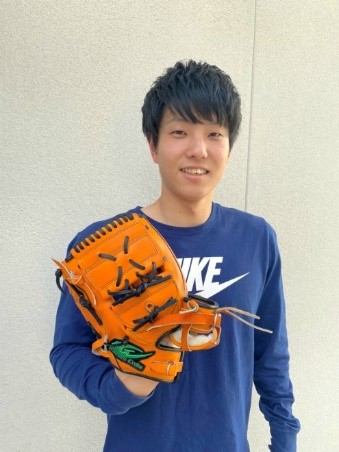Student-designed baseball glove a home run for disabled players

WAKE, Okayama Prefecture- The Asahi Shimbun June 14, 2020)Inspired by an ace baseball pitcher who was born without a left hand, players on the Wakesizutani Senior High School baseball team here sought to further help him on the mound.
Along with a baseball gear manufacturer, two players helped create a special glove for Kenta Hayashima, the star pitcher on a disabled ballplayers' team named Okayama Momotaro.
The revolutionary design is touted as the world's first baseball glove for exclusive use by people with disabilities.
Hayashima, 24, has long had to play with a regular glove, which caused pain to his right elbow due to too much burden.
The idea for a new glove design took root after torrential rains that flooded western Japan in summer 2018 deprived the Okayama Momotaro baseball team of its practice field.
The Wakesizutani school allowed Hayashima and his teammates to use its baseball facilities and provided training assistance.
As Wakesizutani was designated by the education ministry as an institute to promote local cooperation in fiscal 2019, the two teams also jointly organized training sessions, friendly games and other exchange programs.
The Wakesizutani players were impressed by the efforts of Hayashima and other Okayama Momotaro players to develop their own playing styles and wanted to help them.
CHALLENGE TO DESIGN AND CONSTRUCT
The project, which started in December last year, took three and a half months to complete.
The idea came as players watched Hayashima, a right-handed pitcher, throw a ball with his glove tucked under his left arm.
After converting their rough ideas into illustrations, the students sought advice from Romane Crowe, the original glove brand of the Takagi Sports baseball goods store in Okayama.
The designs by Atsuhiro Kono and Ryoichi Hamamoto, both in their second year at the school, were selected from among the blueprints, leading to the development of a glove with a pocket in the back to slide the left arm into.
The finished product does not have a partition between the middle finger and the third finger to enable its user to easily insert the right hand when shifting the glove from the left arm to the right.
The innovation was suggested during discussions between the students and Tetsuya Morikawa, 32, a glove maker. Morikawa said it was particularly difficult for him to increase the durability of the pocket of the glove.
"Making gloves to fit each player is the duty of craftsmen," he said. "The project was a challenge for me as well."
To complete the glove, Morikawa used a stiffer kind of leather that is not typically used in baseball gloves for the base and inserted a plastic sheet into the covering. An adjuster was also added to tighten the glove even after the leather loosens.
According to the Japan Dream Baseball League, disabled athletes are allowed to utilize chairs, crutches and other tools to assist them. As the new glove is regarded as a supplementary item, its use will not pose any problems.
Keiichiro Ukita, the coach of the student baseball team, expressed his intention to "release the second and third products successively" in the future.
Baseball will be reintroduced as an official event of the Tokyo Olympics in 2021 but will not be included in the Paralympics. Ukita hopes that creating equipment for disabled players will contribute to the inclusion of baseball in the sports extravaganza.
DRASTIC CHANGE IN PLAYING BASEBALL
Hayashima described the newly developed glove as "changing my style of playing baseball."
He began playing softball when he was in his fifth year at elementary school, and played a Japanese version of baseball using rubber balls in his junior high school days. He became a regular of the baseball club in the autumn of his first senior high school year.
As a member of the Kibi International University's team, Hayashima was a bench player during the six-college baseball league in the Chugoku region. He would see playing time as an outfielder who could hit and also had exceptional speed on the basepaths.
Hayashima said he "improved his existing tools in my own style," referring, for example, to the glove with a mesh webbing he previously used.
After he threw a ball with the right hand while hanging his glove on his left wrist, he would quickly don it on the right hand to catch a ball. For throwing the ball to a base, Hayashima held his glove between his left arm and left side and would put it on after throwing the ball.
But the practice forced him to pay too much attention to his left arm to prevent dropping the glove while throwing. As a result, he threw balls with only his right arm without using his body, putting strain on his right elbow.
In the fourth World Dream Baseball tournament in fall 2018, Hayashima greatly contributed to his team winning the championship as its top pitcher and was named MVP. However, he continued suffering from elbow pain, so he underwent surgery in March last year.
On returning to practice, Hayashima still felt pain in his elbow. It was then that he heard about the effort to develop a new glove.
When trying out the new gear, Hayashima found his elbow hurting less, allowing him to throw the ball better by taking full advantage of his left arm and other parts of his body.
"I can further refine my skills," said Hayashima. "I want to show off my performance so the potential of people with disabilities will be expanded further."



